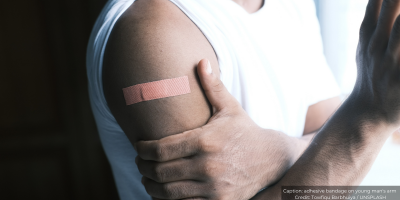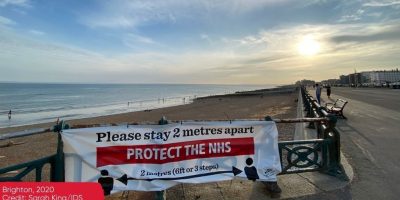G7 countries have succeeded in vaccinating a large proportion of their national populations. Leading the group is Spain, with more than 85% of the population being ‘fully vaccinated’ (2 jabs). The US, the least vaccinated country in the G7, has still managed to fully vaccinate 66% of their total population. However, vaccination is not equally distributed: people living in ethnically diverse urban neighbourhoods are less likely to be vaccinated. This has led to differences in health outcomes. In many cities, people from immigrant backgrounds, as well as minoritized and racialised communities, were more likely to be living in COVID-19 hotspots, while simultaneously being more vulnerable to hospitalisation and death.
Racialised and migrant populations were over-represented in COVID-19 cases, due to longstanding structural vulnerabilities. In high-income countries, these populations disproportionately work in precarious, underpaid, and essential frontline jobs. They are also more likely to live in overcrowded and multigenerational households where it is difficult to isolate the sick. This means within-household transmission is more likely to occur, leading to greater risk of COVID-19 infection. Frontline workers from these communities have been more likely to be exposed to the virus, and due to longstanding health inequity, are also more likely to have co-morbidities and face limited access to health services. This makes them more vulnerable to hospitalisation and death. People from these communities have also been less likely to seek vaccination.
Our research in the northern districts of Marseille and the borough of Ealing in northwest London, summarised in a recent briefing, strongly suggests that local governments can do a lot to reverse these trends. Local authorities in these settings worked collaboratively with local health providers, community groups, and other local actors, resulting in a significant catch-up in vaccine uptake. In the latter half of 2021, Ealing increased its local uptake by 15%, to match rates in Greater London, while vaccination rates in the northern districts of Marseille doubled from 25% to 50% in this period. Low income, minoritized and racialised communities are still the least vaccinated groups, yet it is clear that effective community participation and engagement makes a difference.
Our findings show how local governments in urban areas can build trust amongst racialised and minoritised residents and how they can adapt vaccination programmes to improve vaccine uptake. Below are some key lessons from our research, illustrating how local governments were able to effect change, which will be useful for informing future public health interventions:
- The decentralisation and adaptability of vaccine programmes led to successes in COVID-19 vaccine uptake
Key successes in the local governance of vaccine rollouts in the areas studied were in part due to the autonomy that local authorities – at regional and city level – were granted through decentralisation processes. Where decentralised control was limited, personal and institutional commitments by local authorities to their citizens nevertheless pushed them to fight for and create these spaces of responsibility in the vaccination response. Local authorities’ deep knowledge of the local context and their existing relationships with community groups guaranteed a more tailored response to the diverse populations to whom they are accountable.
- Sustained and longstanding engagement by local authorities with health providers, community groups, and residents has a higher impact on vaccine equity.
Our research illustrated that increased vaccine confidence and uptake was highest where relationships between local authorities and community groups and residents were longstanding. Reactive relationships which were only initiated with community groups to respond to COVID-19 had positive effects, but took longer to build trust. Some community organisations indicated their efforts had not been financed appropriately, leading to burnout. Funds for meaningful engagement with local authorities should be readily available in ‘normal’ times, while new relationships which have emerged as a result of COVID-19 should be consolidated and sustained beyond the pandemic.
- Tailored vaccine services designed and delivered with community groups are especially critical in multicultural urban contexts.
Tailored vaccination sites, using appropriate languages, and health and social work staff from within people’s own communities, all provide a sense of safety. This requires working with community organisations and building on the existing work of community engagement officers in local councils. Community engagement staff are essential for this role of mediation and translation, and more staff should be recruited to work towards health equity.
- Vaccination uptake is higher when there are sites and venues as close to the communities as possible.
Mass vaccination sites have been useful for vaccinating large numbers of people. However, these should be complemented with vaccination clinics nearer to communities. This includes, for instance, pop-up clinics, vaccination buses, local physicians’ practices and pharmacies, as well as door-to-door vaccination for the most vulnerable. These interventions need to be planned strategically and in partnership with community engagement officers.
- Responding to COVID-19 required adapting to structural inequalities.
Living on low incomes and depending on precarious frontline jobs, meant many people were forced to carry on working throughout the pandemic, regardless of their health or of health risks. Only when income support and sick leave were available, and there was cooperation from employers, were people more able and likely to self-isolate when they had COVID-19 symptoms. At the start of the vaccination programme, many precarious workers were also unable to go to vaccination centres. Vaccine uptake increased when clinic opening hours were extended to evenings and weekends, and when people were able to be vaccinated in their workplaces.
- Mistrust stems from historical inequities and social injustices in health, as well as other aspects of people’s lives.
People living in multicultural areas, especially racialised and minoritized communities, have experienced historical discrimination and inequality. As a result, they see their interaction with the state and health providers through a lens of mistrust. Furthermore, other factors such as inadequate housing, transport, and precarious employment, and limited welfare exacerbate their feelings of being left behind. Health services are often either unavailable, difficult to access, poor quality, or people may experience discrimination when accessing them. This creates an ‘us vs. them’ attitude that leads to mistrust of vaccination. This may lead people to ask, ‘why now?’, as their previous experiences of the state may be primarily characterised by neglect or direct hostility (as in the case of surveillance and police violence), rather than by care. Addressing these inequities in housing, employment, public services, and health are necessary to build trust.
- Communicating in languages people are comfortable and proficient in and offering cultural safety are drivers of health equity.
As we explain elsewhere, language is a critical factor in driving or hindering health equity. Using languages people are most comfortable and proficient in enables not only the flow of important information, but also the building of trust necessary for people to feel comfortable to get vaccinated, or to engage in other health promoting behaviours.
Ultimately, lessons from the COVID-19 pandemic illustrate that the successful delivery of vaccination programmes is about relationships. Local authorities have played important roles in closing vaccination gaps. They can continue to support health equity in other areas, in both emergency and non-emergency times. Local government authorities often live in and regularly interact with the communities they support. By establishing relationships and building up a knowledge of local needs – which can be incredibly varied in ‘superdiverse’ communities such as those in northern Marseilles and in Ealing – local government are well-placed to deliver effective programming. Their capacity is further improved when granted with autonomy and resources to act meaningfully, and when teams and leaders have and commitment to serve. That said, local authorities aren’t automatically effective. What these lessons highlight is how important it is to centre people, relationships, trust, and solidarity: both within and between administrative and health authorities, and diverse communities. It is upon these building blocks – which now must be further nurtured and sustained in the wake of COVID-19 – that the future of health equity in G7 countries (and beyond) depends.





